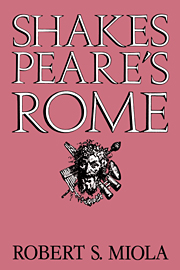Book contents
- Frontmatter
- Contents
- Acknowledgments
- Notes on sources
- I The roads to Rome
- II The Rape of Lucrece: Rome and Romans
- III Titus Andronicus: Rome and the family
- IV Julius Caesar: Rome divided
- V Antony and Cleopatra: Rome and the world
- VI Coriolanus: Rome and the self
- VII Cymbeline: Beyond Rome
- VIII Conclusion
- Index
IV - Julius Caesar: Rome divided
Published online by Cambridge University Press: 28 October 2009
- Frontmatter
- Contents
- Acknowledgments
- Notes on sources
- I The roads to Rome
- II The Rape of Lucrece: Rome and Romans
- III Titus Andronicus: Rome and the family
- IV Julius Caesar: Rome divided
- V Antony and Cleopatra: Rome and the world
- VI Coriolanus: Rome and the self
- VII Cymbeline: Beyond Rome
- VIII Conclusion
- Index
Summary
Shakespeare's third imaginative encounter with Rome embodies, develops, and transforms much of what has gone before. Sharply defined by recognizable localities such as the Capitol, marketplace, and walls, Rome is the central protagonist of the play. The city again shapes the lives of its inhabitants, who struggle to act according to Roman heroic traditions. As in Lucrece and Titus Andronicus the ideals of honor and constancy here make up the moral universe. And as in the earlier Roman works, Shakespeare shows continuing concern with the Roman family, though in this play women emerge more fully and the demands of Roman pietas become paradoxical and destructive. The barbarism inherent in Shakespeare's Rome repels us again, although the Roman ceremonies and blood rituals on this stage more effectively undercut action, provoke thought, and develop theme. As the crudely articulated revenge motif of Lucrece and Titus Andronicus changes form here, the light and incidental sketch of the city divided becomes the sharper and darker blueprint for the action.
Unlike the protagonists of the earlier works, Julius Caesar was a classical figure of commanding importance to Renaissance historians, mythographers, moralists, playwrights, and poets. Shakespeare appropriates the famous story not to illustrate the evils of tyranny, rebellion, or both, but to give his audience a look at a pivotal moment in Roman history. As Ernest Schanzer and others argue, Shakespeare here creates a play that accommodates, even insists upon, the complexity and ambivalence of Caesar's story. To a greater extent than before, he, like Plutarch, focuses on the characters in the historical pageant, on the human beings who by some combination of nature's livery and fortune's star strutted or stumbled into legend and song.
- Type
- Chapter
- Information
- Shakespeare's Rome , pp. 76 - 115Publisher: Cambridge University PressPrint publication year: 1983



